Delightfully lemony and super creamy, this baked lemon curd cheesecake is sure to please. While this mini cheesecake is perfect for portion control, you'll get big flavor in every bite!
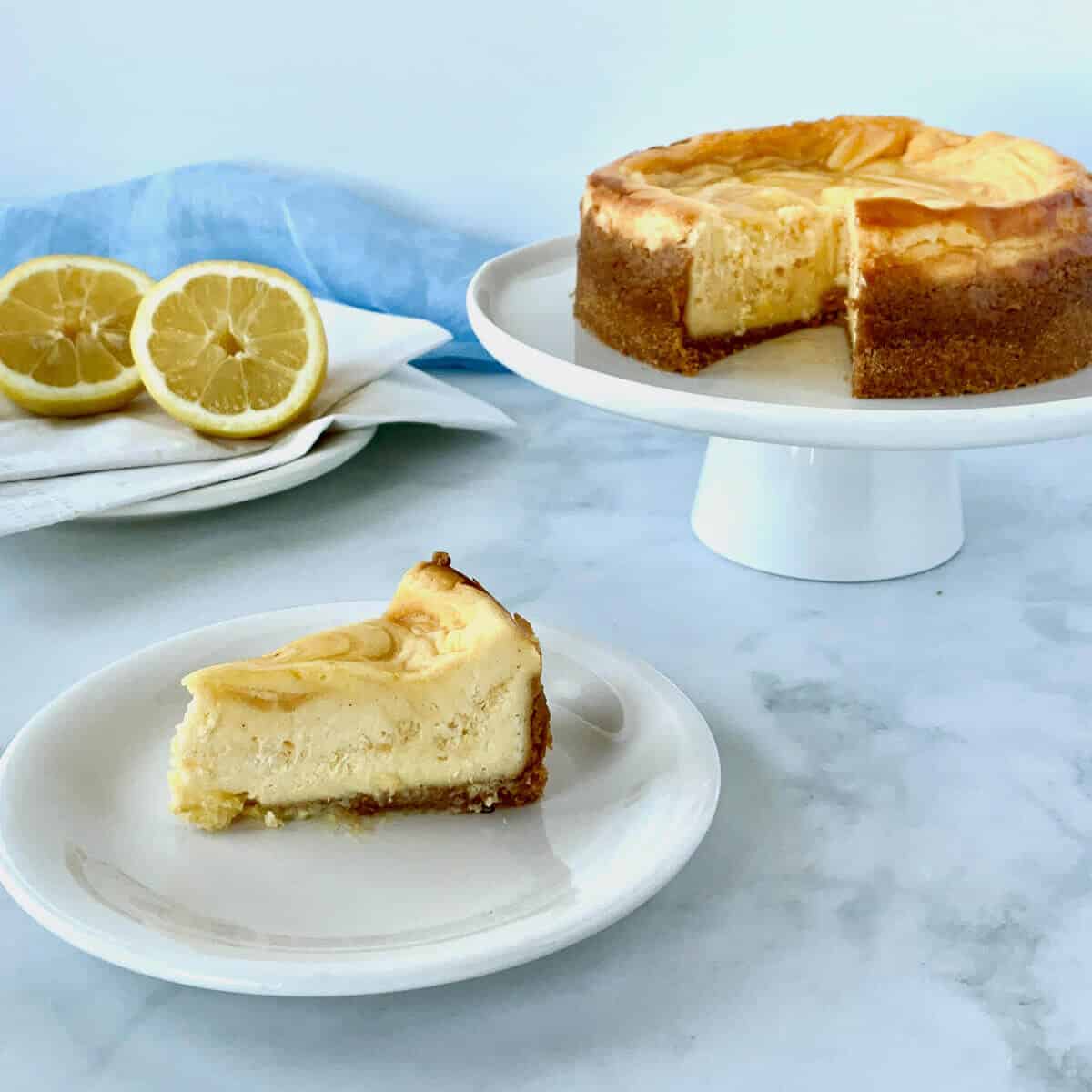
Jump to:
[May, 2021: I've reworked the recipe and updated this post with all new pictures. Enjoy!]
Why this recipe works
- Smooth and creamy cheesecake with a sweet tart lemon curd swirled into every bite
- Use homemade or store bought lemon curd, or use another fruit curd flavor
- There's lots of tips and tricks for cheesecake success
- Mini baked cheesecake is perfect for portion control
I love lemon in recipes. Give me a piece of lemon-glazed shortbread, a scoop of lemon sherbet, a tender and flaky lemon scone, or a slice of lemon icebox pie and it's like the sun has come out, no matter the weather.
Lemon curd is traditional to have with cream scones, and it's super easy to make at home. Where else can I use it?
How about making a Lemon Curd Cheesecake? Swirls of delicious lemon curd throughout a creamy, dreamy cheesecake filling. Smooth, luscious, and lemony, this baked Lemon Curd Cheesecake recipe hits all the high notes. And making it in a 6-inch round springform pan provides a measure of portion control. That's important when you're feeding a smaller group.
This mini lemon curd cheesecake is rich, dense (in a good way), not overly sweet with a lovely balance of lemony tang. The crust is perfect (packing it down really helps!), and it holds up without being soggy.
A slice of this lemon cheesecake will give you bright lemon flavor, like a sunny Spring day. In other words, it's delicious! And the small size is perfect for a small gathering, yet everyone gets a big enough slice.
Recipe Ingredients
You'll need the following ingredients to make this lemon curd cheesecake recipe:
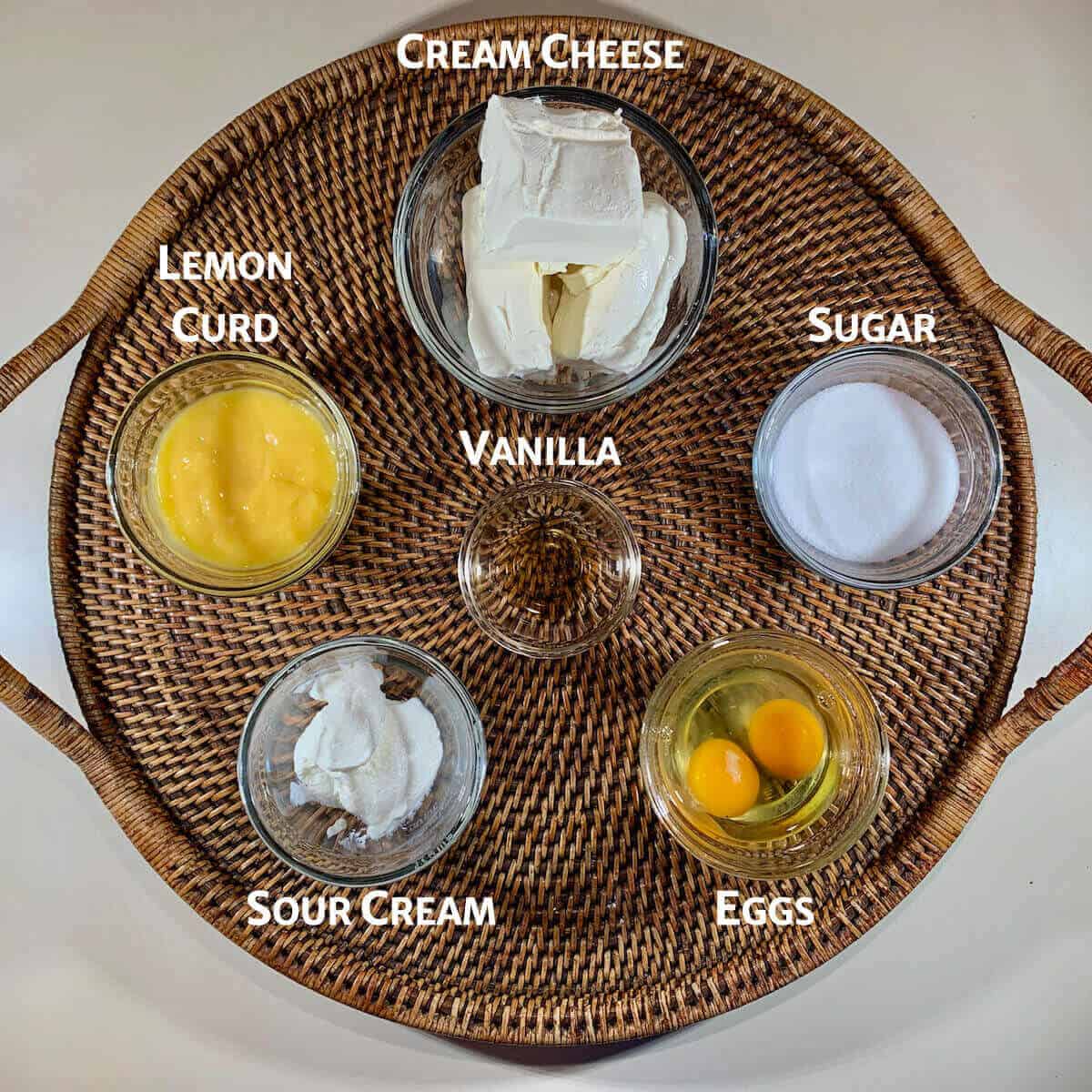
Ingredient Notes
It's important to have the cream cheese, sour cream, and eggs at room temperature before beginning. They’ll combine quickly and evenly so you won’t risk over-mixing the batter. Beating cold ingredients together will result in a chunky cheesecake batter, and who wants that?
Cream cheese: Use full fat bricks of cream cheese. Now isn’t the time for reduced fat or nonfat cream cheese - they contain fillers that might prevent the cheesecake from setting properly. Also, never substitute whipped cream cheese for the solid block (you don't want that extra air).
Sour cream: Like with the cream cheese, use full fat sour cream.
Lemon curd: Homemade lemon curd will provide the bright, clean, tart flavor this cheesecake needs. However, you can use store bought curd if you prefer. You can also use another fruit curd flavor if you prefer, like in this Blackberry Cheesecake.
Graham cracker crust: Baking the graham cracker crust sets it and keeps it from getting soggy or shifting when the cheesecake batter is added. Let the crust cool completely before adding the filling.
See the recipe card for a full list of ingredients and measurements.
How to make lemon curd cheesecake
Step 1: Make the crust
A good baked cheesecake recipe starts with a good base. A classic graham cracker crust, to be specific.
Use a food processor to make graham cracker crumbs (or to get your aggressions out, put them in a ziplock bag and beat the hell out of them crush them with a rolling pin).
Press the graham cracker mixture firmly on the bottoms and sides of a 6-inch round springform pan (photo 1), then bake it for 10 minutes. That will insure your crust will hold together.
Let the crust cool while you make the cheesecake custard filling.
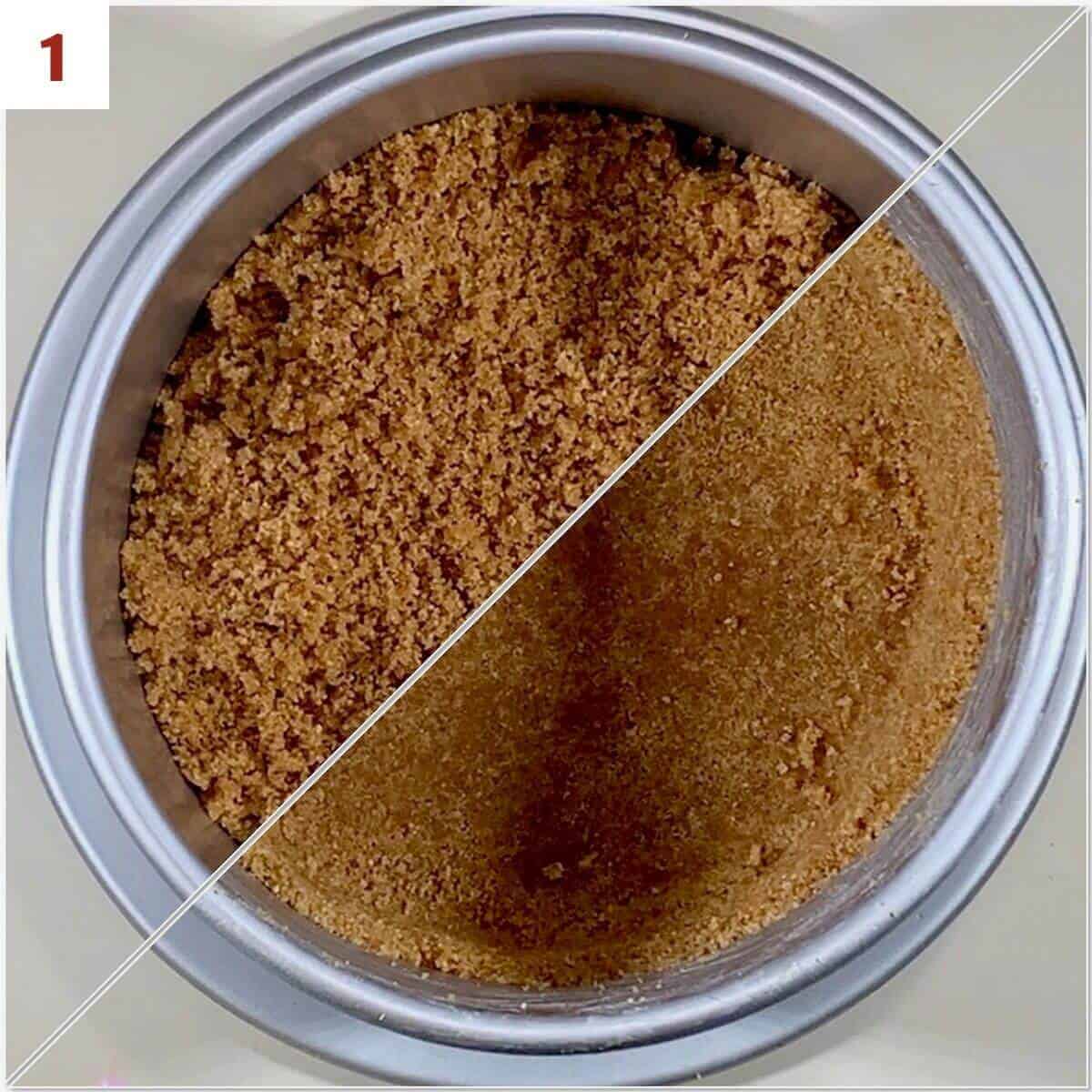
Step 2: Make the cheesecake filling
Start by beating the cream cheese and sugar together until the mixture is creamy and smooth (photo 2).
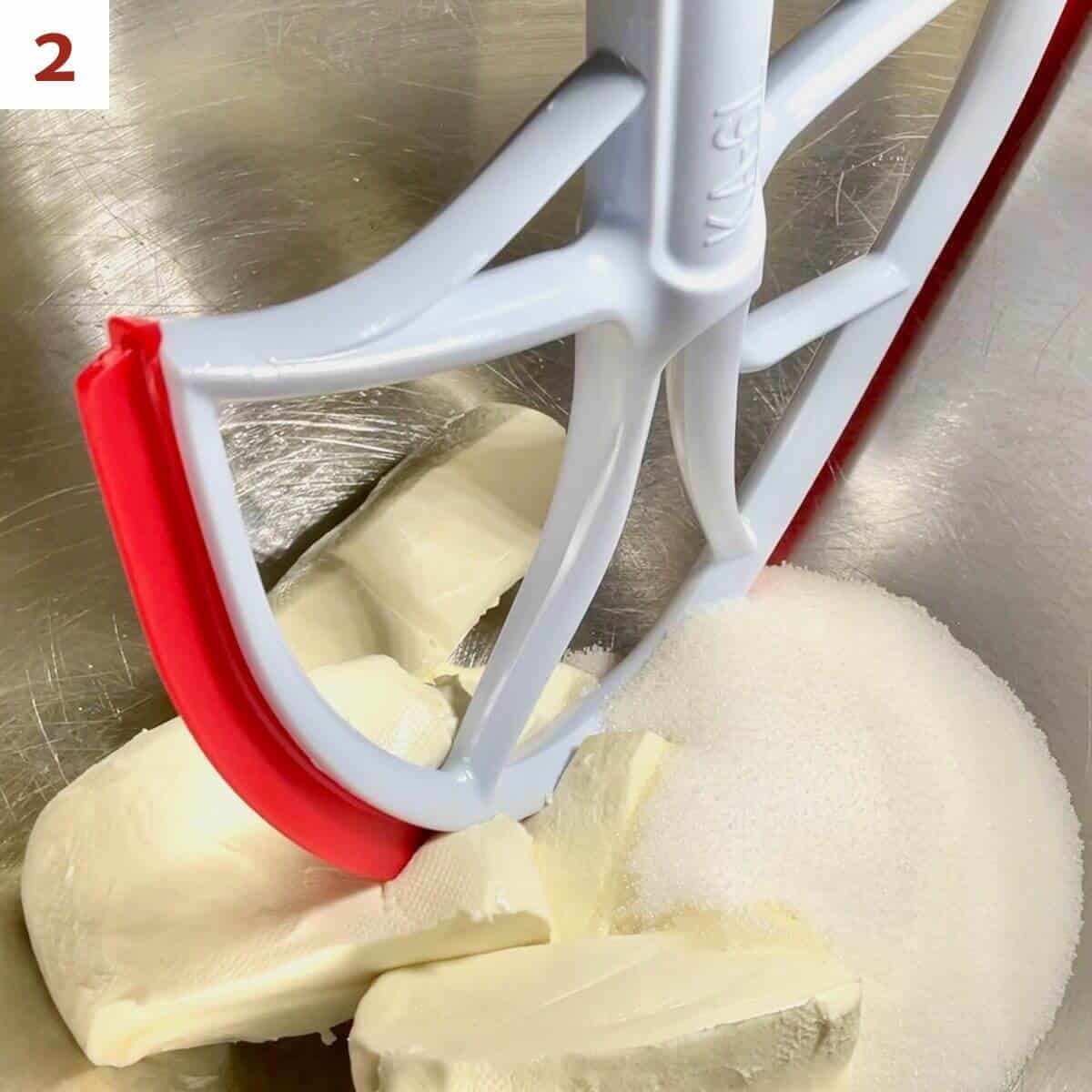
Add the sour cream and vanilla to the mixture and beat until smooth (photo 3).
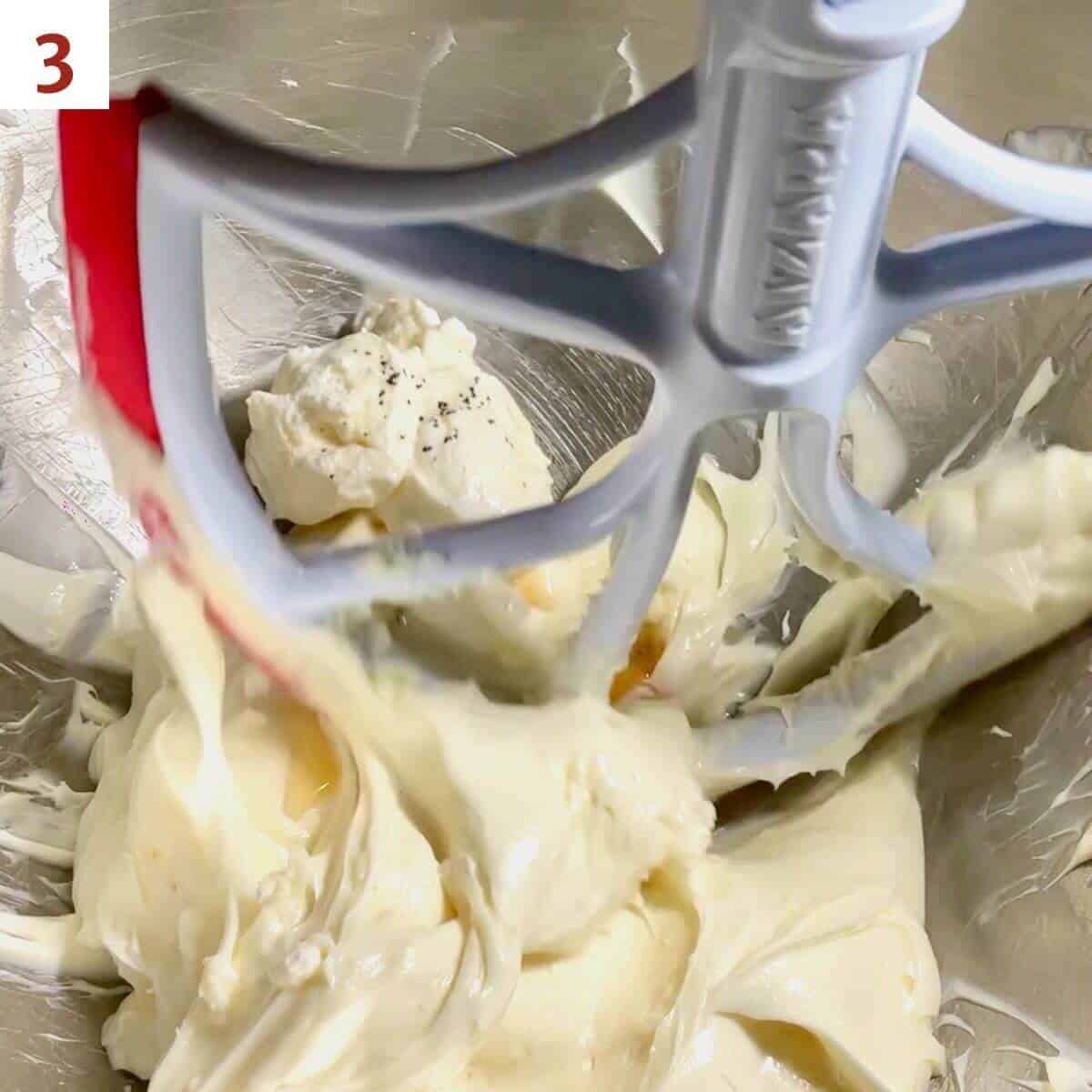
On medium speed, add the eggs one at a time, beating after each addition until just blended. The idea is to incorporate the eggs without adding too much air (photo 4).
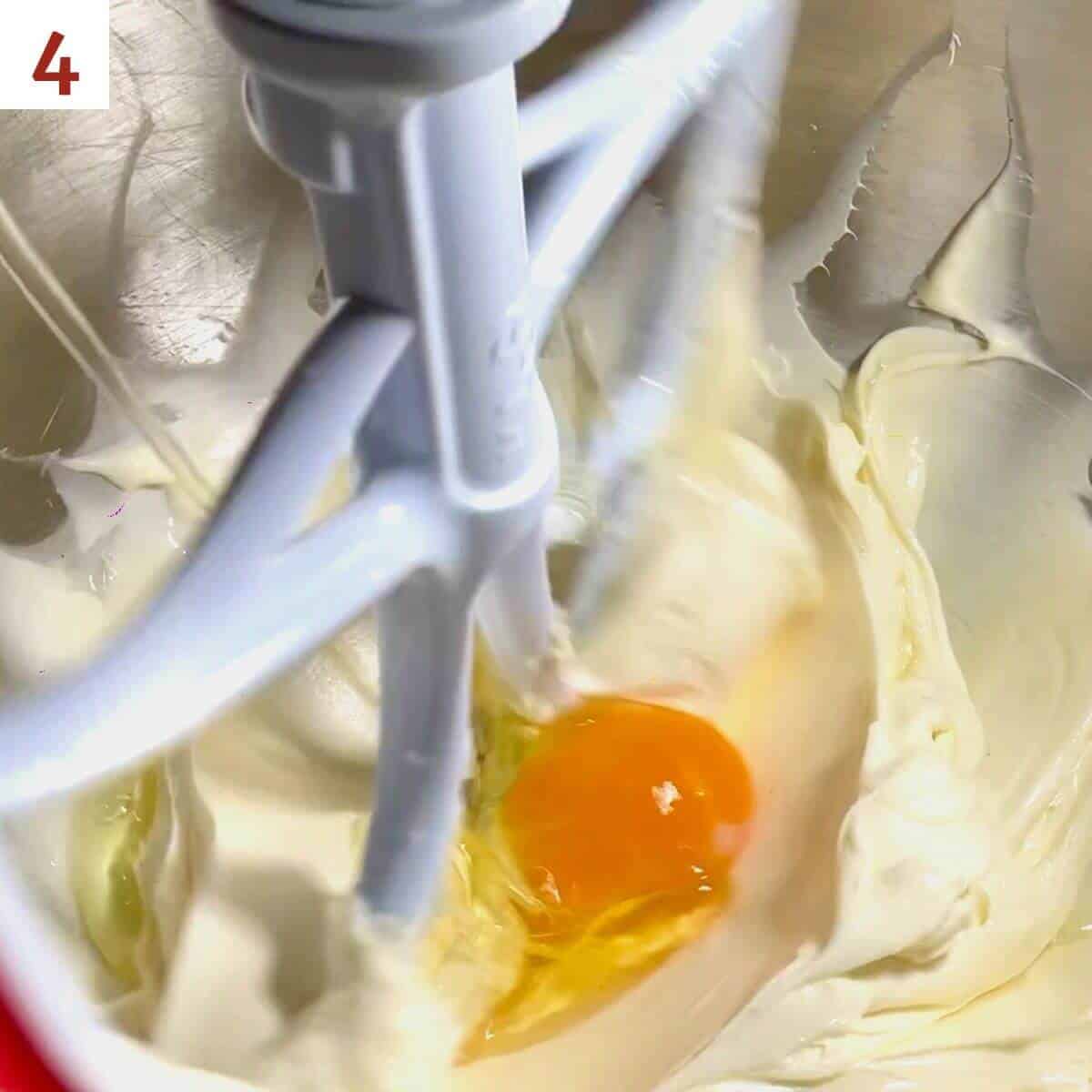
Don't overmix the cheesecake filling!
The most important tip to remember when making a cheesecake filling is to mix only until the ingredients are incorporated, especially when adding in the eggs. After the final egg is incorporated into the batter, stop mixing! You don't want to add air into the mix or the filling will crack or bubble during baking.
Step 3: Swirl in the lemon curd
Before adding the cheesecake batter to the cooled crust, use a pastry brush to spread melted butter on the inside of the pan from the top of the crust to the top edge. This helps keep any batter that rises above the crust from sticking to the pan.
Pour ⅔ of cream cheese filling into the crust, then spoon half of lemon curd over filling and swirl curd into filling with a small knife (photo 5). Avoid touching crust with knife to prevent crumbs getting into filling.
Repeat with remaining filling and curd. Tap the pan gently on the counter to release any trapped air bubbles.
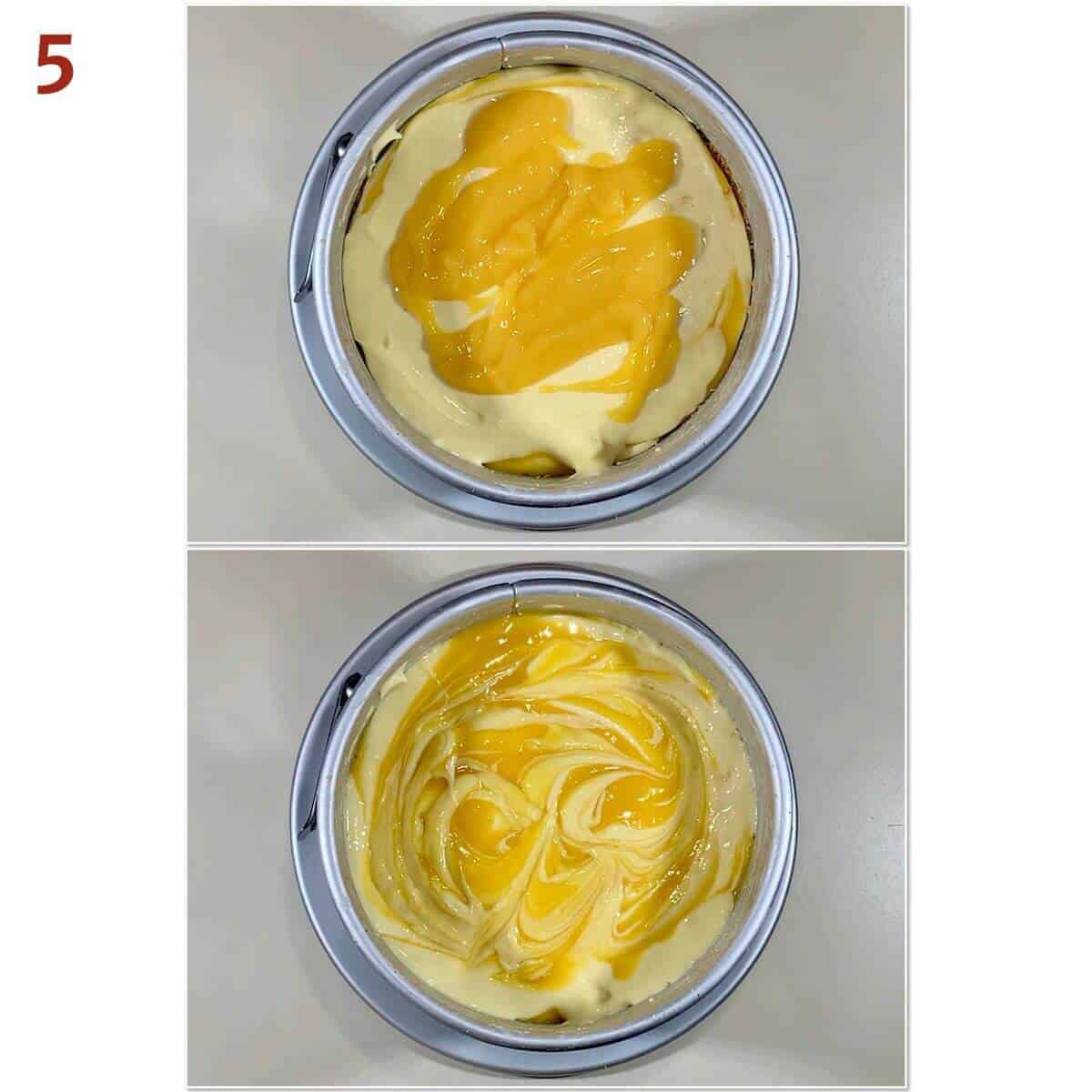
Step 4: Bake the cheesecake
Bake the lemon curd cheesecake in a water bath at 325˚F for 50 to 55 minutes or until the center is almost set (photo 6). If you notice the cheesecake browning too quickly on top, tent it with aluminum foil halfway through the baking time.
When it's done, the center of the cheesecake will slightly wobble if you gently shake the pan.
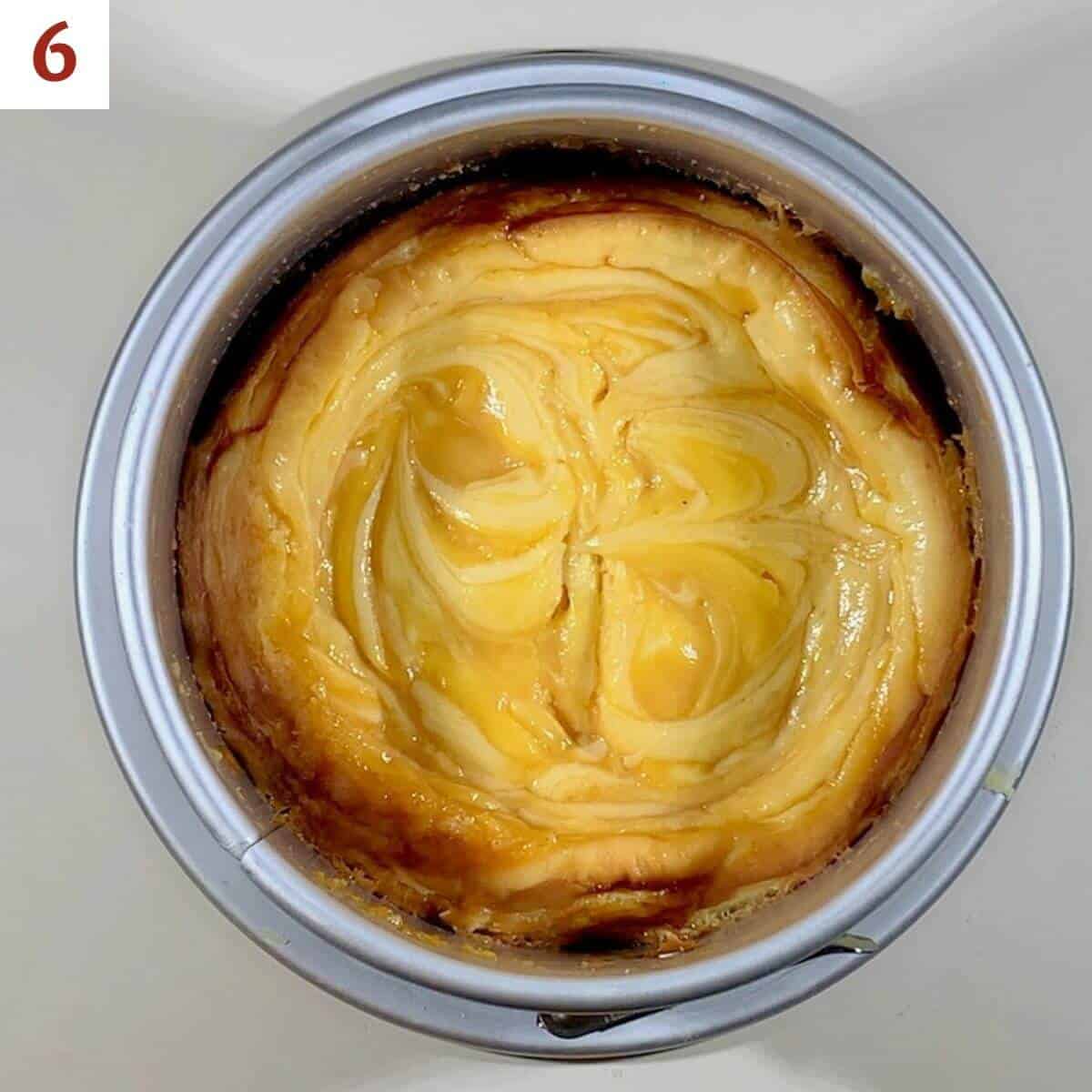
How to use a water bath when baking cheesecake
There are 2 ways to make a water bath, and they depend on the size of your springform pan:
Method 1: Springform pan fits in a larger pan
If you have a roasting pan large enough to fit your springform pan, wrap the outside of the springform pan in a double layer of foil, covering the bottom and extending all the way to the top. Although a good crust keeps filling from leaking out, the foil helps protect against water leaking in.
Set the wrapped cheesecake in a large roasting pan, and pour hot water into the roasting pan until it reaches halfway up the sides of the springform pan.
Method 2: Springform pan doesn't fit in a larger pan
I don't have a roasting pan large enough to fit my springform pan. Instead, I use a substitute trick by placing a 9- x 13-inch baking pan of water on a lower rack in the oven to create steam. By placing the cheesecake directly above this pan in the oven, enough steam is created to insulate the cheesecake.
For either method, if you don't fill the pan with enough water, the sides of the cheesecake can get over-browned. Be warned.
Step 5: Cool the cheesecake gently
It's important to cool the cheesecake gradually to avoid cracks. Turn the oven off and open the oven door slightly. Let the cheesecake sit in the oven (with the water bath) as it cools down for 1 hour. This allows the cheesecake to avoid sudden temperature changes, again keeping it from cracking.
Remove the cheesecake from the oven, then cool it completely at room temperature.
Refrigerate the cheesecake for at least 4 hours or overnight. Use a knife to loosen the chilled cheesecake from the rim of the springform pan, then remove the rim. If there is a ridge on the cheesecake, you can use a sharp knife to trim it away to make the top appear smooth.
Cut the cheesecake into slices with a sharp knife, wiping the knife and dipping it into warm water between each cut to get nice, neat slices.
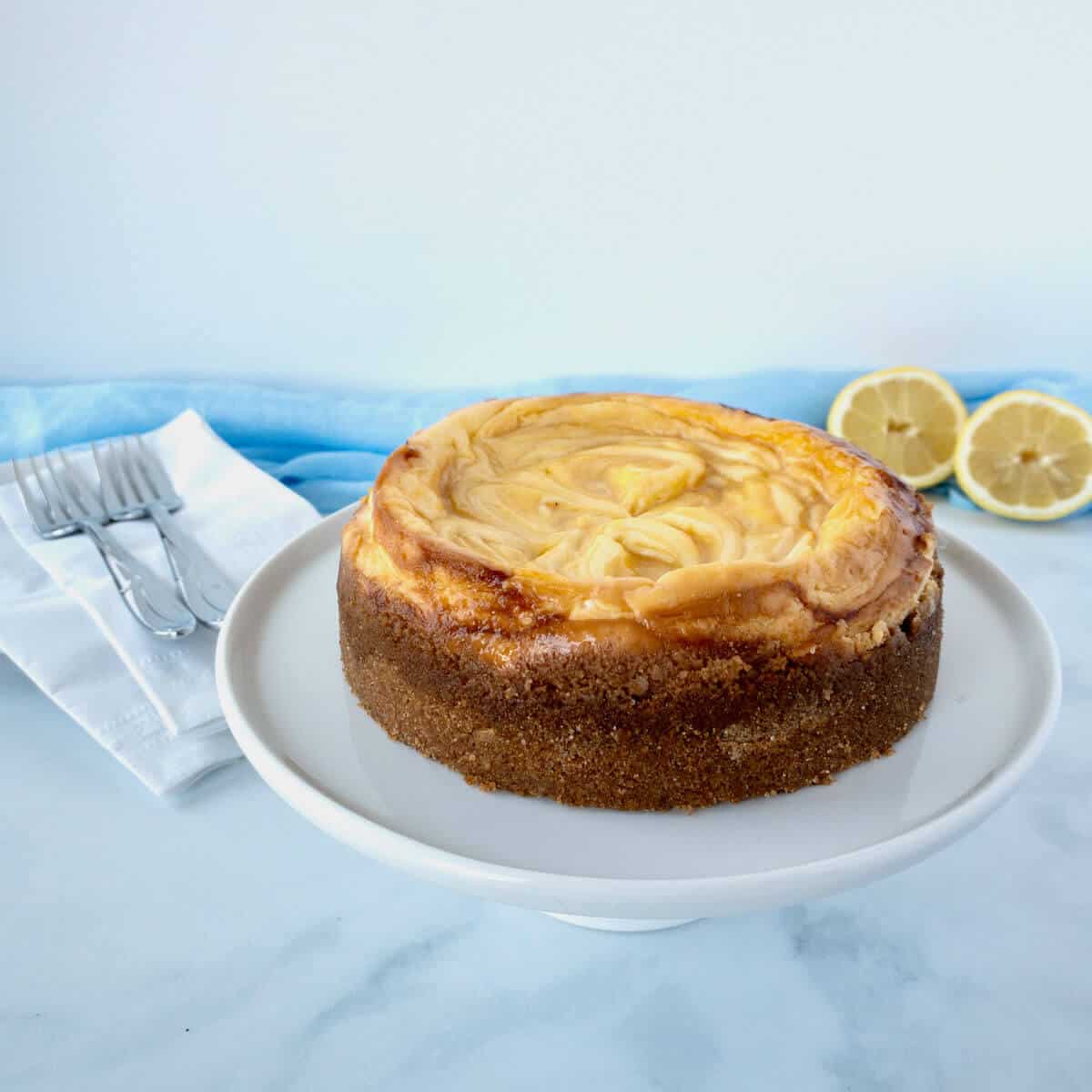
Storage and make-ahead instructions
Storage instructions: Cheesecake can be stored, covered, in the refrigerator for up to 5 days.
Make-ahead instructions: Lemon curd can be stored in an airtight container, like a canning jar, in the refrigerator for 3 to 4 weeks, and in the freezer for up to 1 year. Thaw overnight in the refrigerator before using.
Cooled graham cracker crusts can be stored tightly wrapped with plastic wrap in the refrigerator for 3 days, or in the freezer for 3 months.
The cheesecake itself is best made the day before you want to serve it since it has to chill for quite some time.
Another way to make this cheesecake ahead of time is to freeze it - it can be frozen for up to 3 months. Here's a helpful tutorial for freezing cheesecakes. When you're ready to serve, thaw it overnight in the refrigerator before serving.
Yield Notes
This recipe is sized to make a mini cheesecake. To make a full-sized cheesecake, just double the ingredient amounts and bake in a 9-inch round springform pan for 55 to 70 minutes.
Questions asked and answered
Here are some questions you might have...
You'll notice that I emphasized that the cream cheese, sour cream, and eggs should be at room temperature. They’ll combine quickly and evenly so you won’t risk over-mixing the batter. Beating cold ingredients together will result in a chunky cheesecake batter, and who wants that?
Now isn’t the time for reduced fat or nonfat cream cheese or sour cream. They contain fillers that might prevent the cheesecake from setting properly. Also, never substitute whipped cream cheese for the solid block (again, you don't want that extra air).
Don't over-whip the filling as you're adding in the eggs. You don’t want air beaten into the eggs because it causes them to inflate while baking, then deflate when cooled. This can crack the cheesecake or form bubbles on the surface.
Also, allow the cheesecake to cool slowly by turning off the oven and crack open the oven door. The set custard will gradually deflate, helping to minimize cracking.
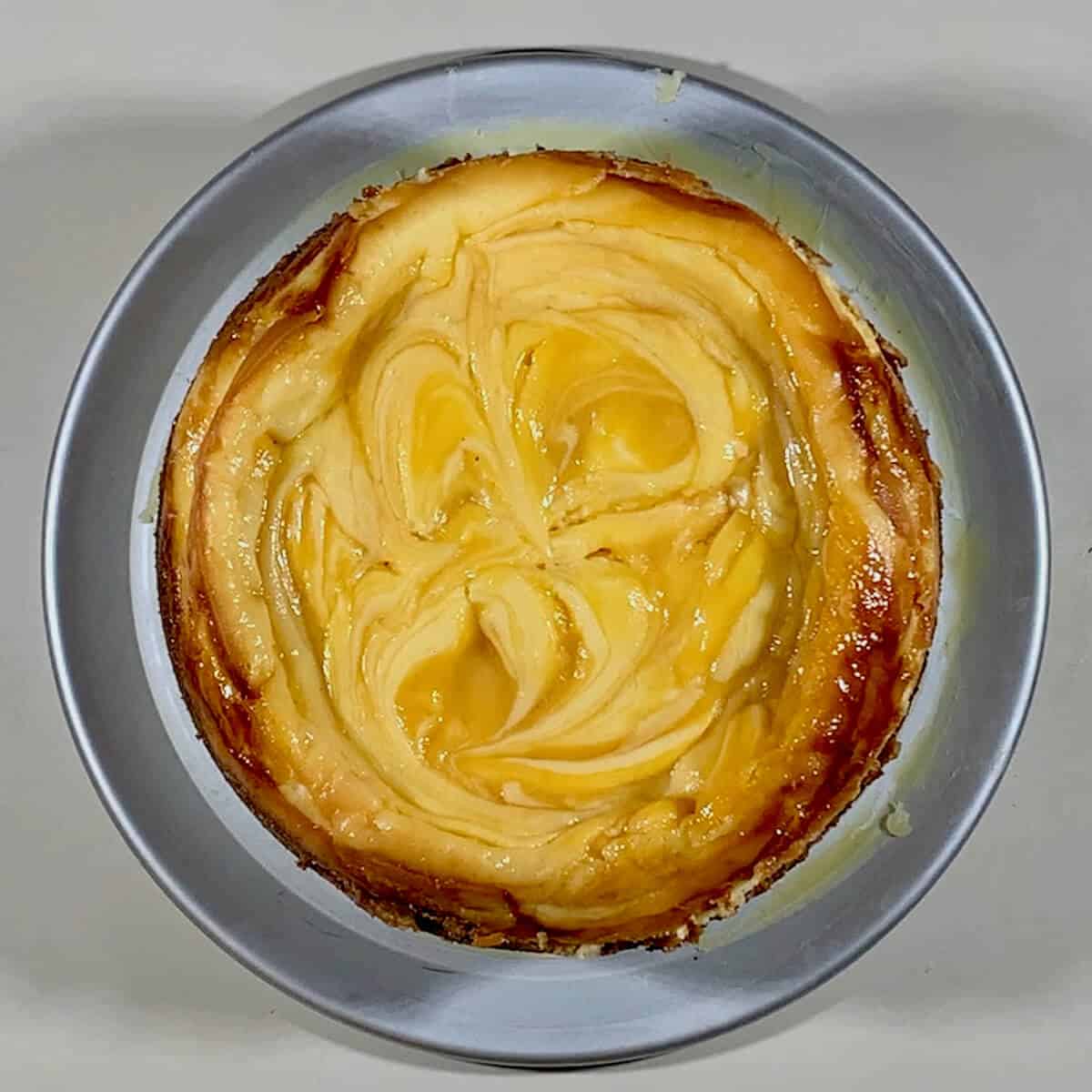
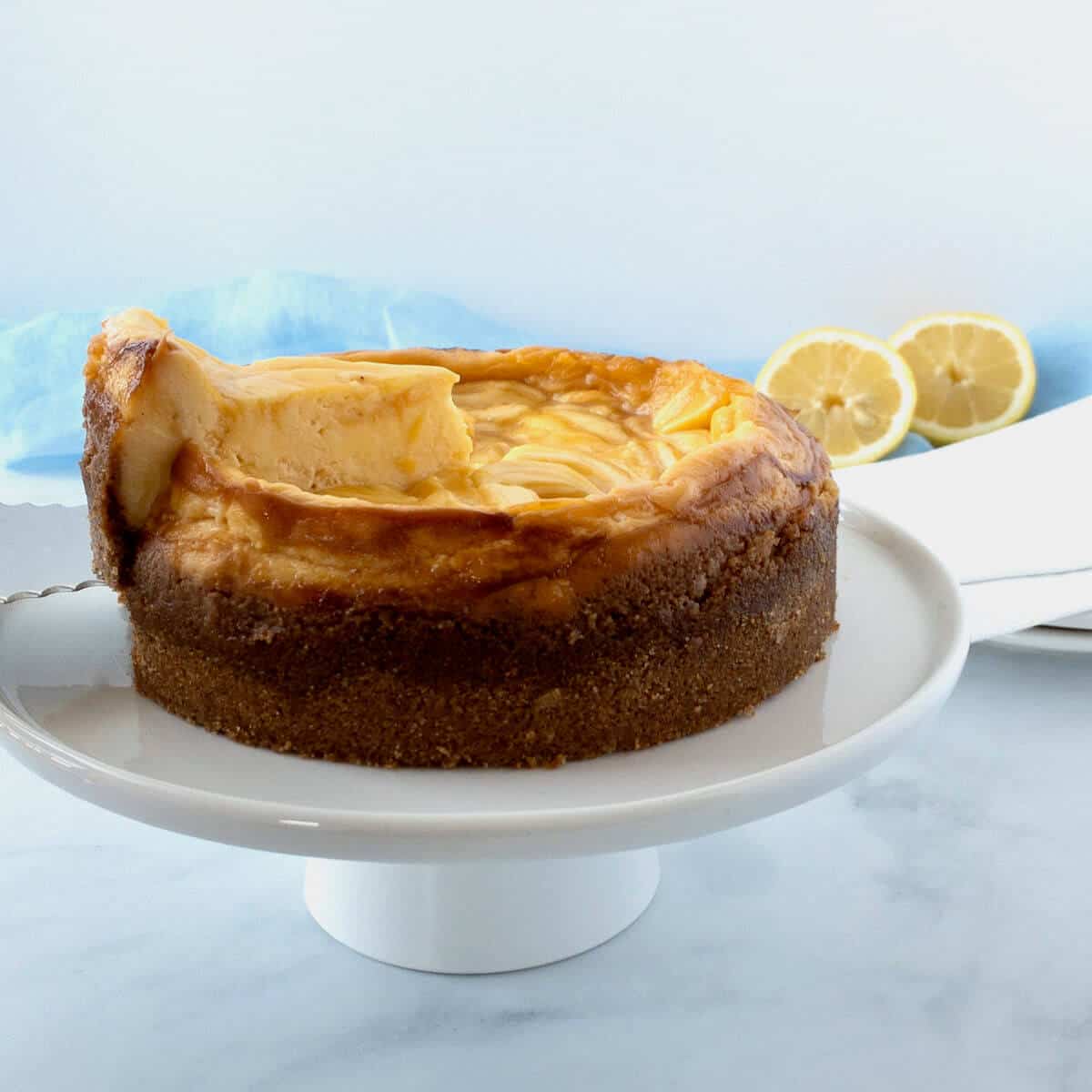
More recipes with citrus to try
Recipe
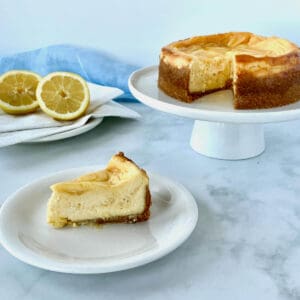
Lemon Curd Cheesecake
Equipment
- large roasting pan or 9- x 13-inch baking pan
Ingredients
For the crust
- ½ recipe graham cracker pie crust, see Recipe Notes
For the filling
- 1½ cups cream cheese, full fat, at room temperature, see Recipe Notes (1½ blocks)
- ½ cup granulated sugar
- ¼ cup sour cream, full fat, at room temperature, see Recipe Notes
- 1 teaspoon vanilla extract
- 2 large eggs, at room temperature, see Recipe Notes
- 1 tablespoon unsalted butter, melted
- ½ cup lemon curd, homemade or store bought
Instructions
- Adjust the oven rack to the lower third position and preheat the oven to 350 °F.
- Check to see if your 6-inch round springform pan fits in a large roasting pan (to use for the water bath). Don't worry if your roasting pan isn't big enough, just use a 9- x 13-in roasting pan to create steam (see water bath instructions below).
- Make the crust: Prepare a graham cracker pie crust and press into the 6-inch round springform pan (you don't have to grease the pan first). Use a pastry tart tamper, the bottom of a measuring cup, or a straight sided glass tumbler to pack the crust down tightly.
- Bake the crust for 10 minutes, then remove the pan from oven and cool completely. Reduce the oven temperature to oven to 325 °F.
- Make the filling: Using a stand mixer fitted with a paddle attachment or a hand mixer, beat the cream cheese and sugar together on medium-high speed in a large bowl until the mixture is smooth and creamy, about 2 minutes. Add the sour cream and vanilla extract, then beat until fully combined.
- On medium speed, add the eggs one at a time, beating after each addition until just blended. After the final egg is incorporated into the batter, stop mixing. You don't want to over-beat the mixture to help prevent the cheesecake from deflating and cracking as it cools.
- Before adding the cheesecake batter to the cooled crust, use a pastry brush to spread melted butter on the inside of the pan from the top of the crust to the top edge. This helps keep any batter that rises above the crust from sticking to the pan.
- Pour ⅔ of the filling into the cooled crust, then spoon ½ of the lemon curd over the filling. Swirl the curd into the filling with a small knife (avoid touching crust with knife to prevent crumbs getting into filling). Repeat with the remaining filling and lemon curd. Tap the pan gently on the counter to release any trapped air bubbles.
- Prepare the water bath: If you have a roasting pan large enough to fit your springform pan, wrap the outside of the springform pan in a double layer of foil, covering the bottom and extending all the way to the top (although a good crust keeps filling from leaking out, the foil helps protect against water leaking in). Set the wrapped cheesecake in the large roasting pan, and carefully pour hot water into the roasting pan until it reaches halfway up the sides of the cheesecake (about 2 inches). Carefully transfer the roasting pan to the lower third rack in the oven.
- If you don't have a roasting pan large enough to fit your springform pan, place a 9- x 13-inch baking pan at the bottom of the oven (or the lowest shelf). Pour in enough hot water to reach halfway up the sides of the pan. This creates the steam to simulate the water bath. Put the cheesecake on the lower-third rack directly above the water-filled pan.
- Continuing: Bake the cheesecake for 50 to 55 minutes or until the center is almost set. If you notice the cheesecake browning too quickly on top, tent it with aluminum foil halfway through the baking time. When it's done, the center of the cheesecake will slightly wobble if you gently shake the pan.
- Turn the oven off and open the oven door slightly. Let the cheesecake sit in the oven (with the water bath) as it cools down for 1 hour. This allows the cheesecake to avoid sudden temperature changes, again keeping it from cracking. Remove the cheesecake from the oven, then cool it completely at room temperature.
- Refrigerate the cheesecake for at least 4 hours or overnight. Use a knife to loosen the chilled cheesecake from the rim of the springform pan, then remove the rim.
- Cut the cheesecake into slices with a sharp knife, wiping the knife and dipping it into warm water between each cut to get nice, neat slices.
- Storage instructions: Cheesecake can be stored, covered, in the refrigerator for up to 5 days.
- Make-ahead instructions: Lemon curd can be stored in an airtight container, like a canning jar, in the refrigerator for 3 to 4 weeks, and in the freezer for up to 1 year. Thaw overnight in the refrigerator before using.Cooled graham cracker crusts can be stored tightly wrapped with plastic wrap in the refrigerator for 3 days, or in the freezer for 3 months.The cheesecake itself is best made the day before you want to serve it since it has to chill for quite some time.Another way to make this cheesecake ahead of time is to freeze it - it can be frozen for up to 3 months. Here's a helpful tutorial for freezing cheesecakes. When you're ready to serve, thaw it overnight in the refrigerator before serving.

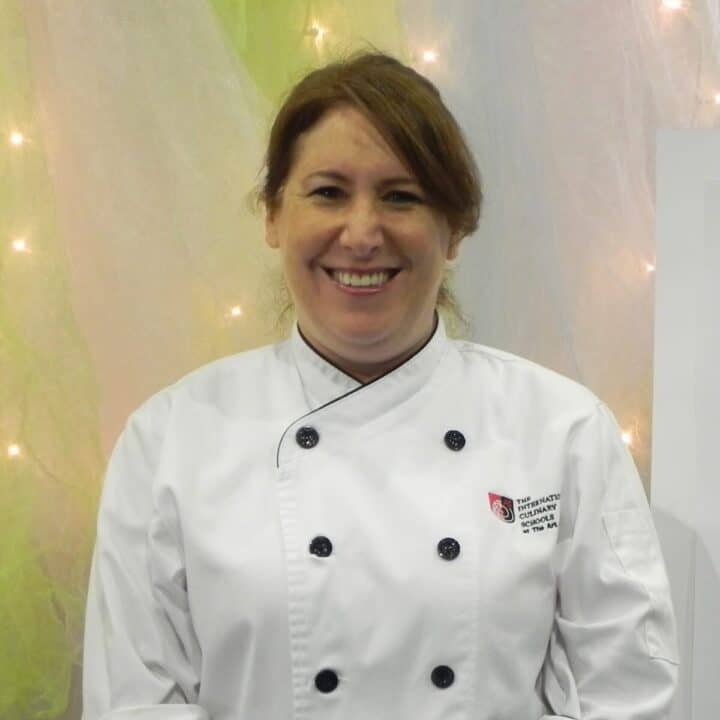
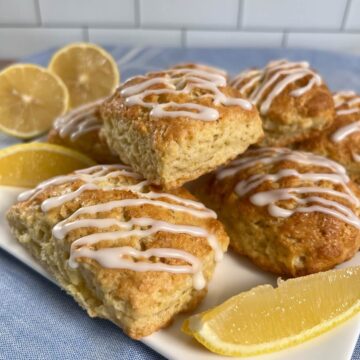
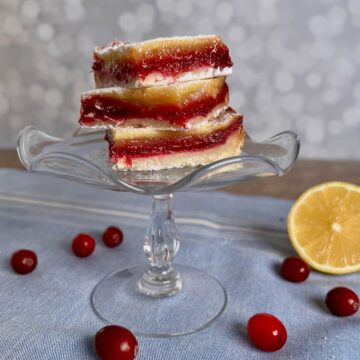
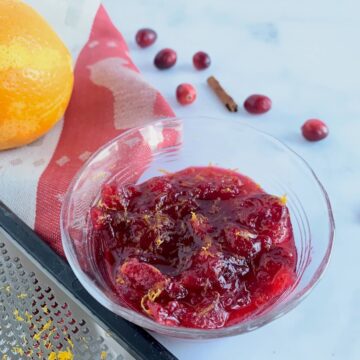
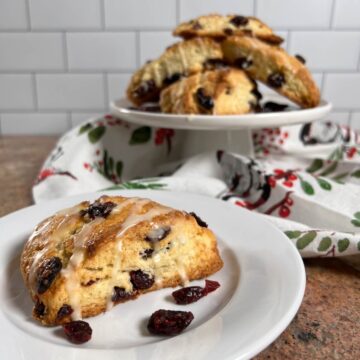
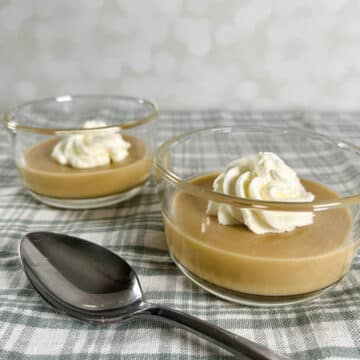
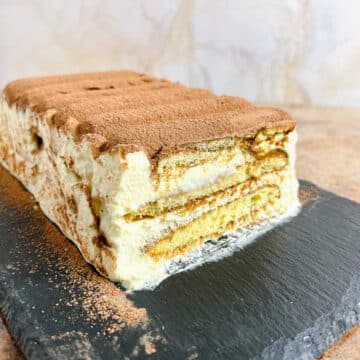
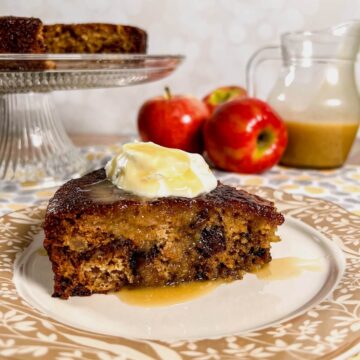
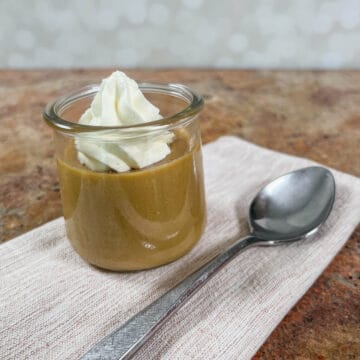
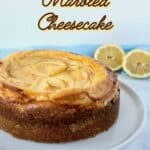
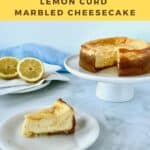
Let's Talk